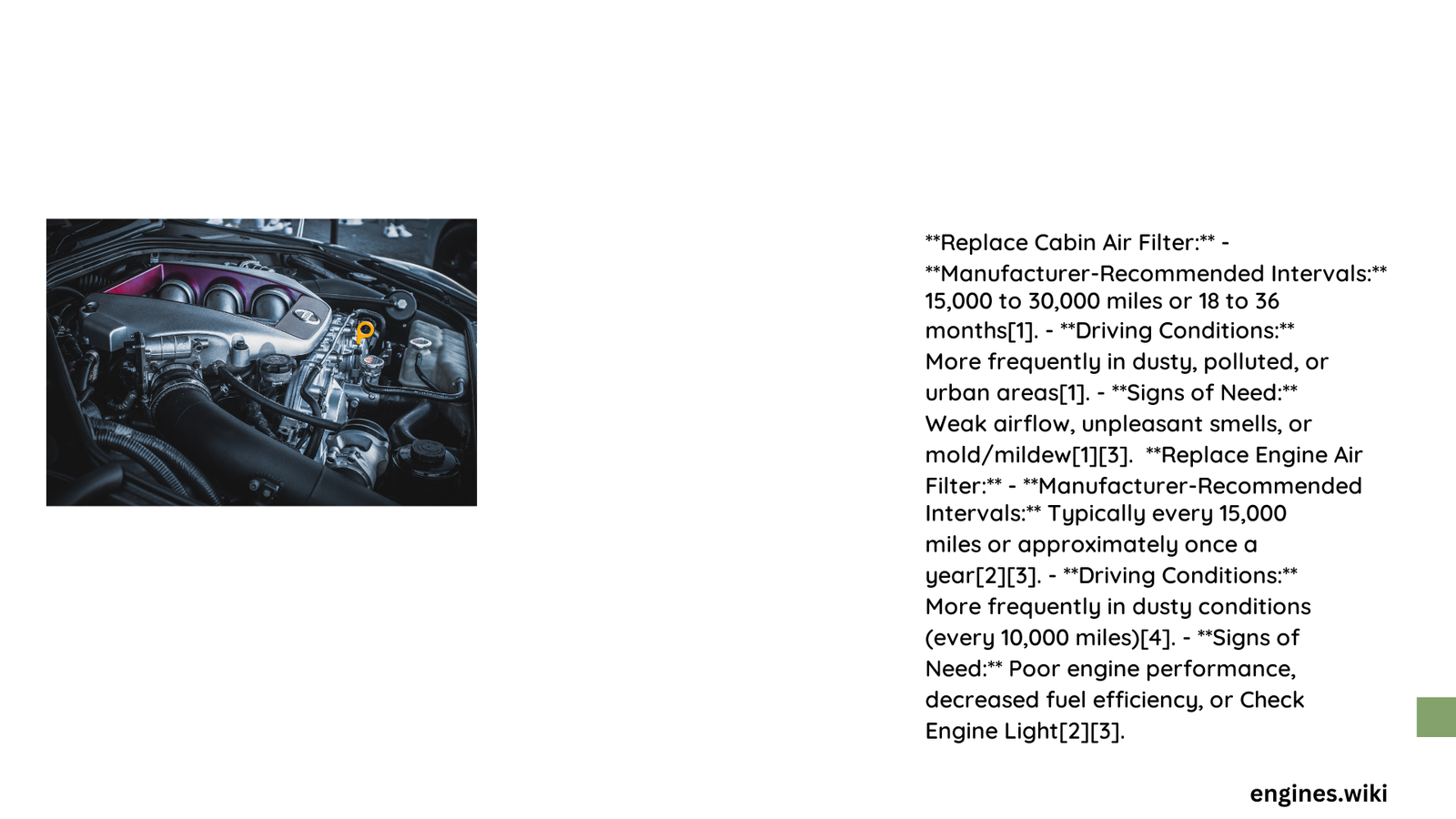Vehicle air filters are critical components that protect your engine and cabin from harmful contaminants, dust, and pollutants. Regular replacement ensures optimal air quality, engine performance, and prevents potential damage to your vehicle’s critical systems. Understanding the right time and indicators for replacing cabin and engine air filters can save you from costly repairs and maintain a healthy driving environment.\n\n## What Determines Air Filter Replacement Intervals?\n\nAir filter replacement depends on multiple factors beyond simple mileage. These include:\n\n- Driving Environment\n – Urban areas with high pollution\n – Dusty or construction-heavy regions\n – Off-road or rural driving conditions\n\n- Vehicle Usage\n – Daily commuting\n – Long-distance travel\n – Frequency of short trips\n\n### How Often Should You Replace Cabin Air Filters?\n\nCabin air filters typically require replacement based on specific guidelines:\n\n| Replacement Metric | Recommended Interval |\n|——————-|———————-|\n| Mileage | 12,000 – 15,000 miles |\n| Time | Once per year |\n| Severe Conditions | Every 6-8 months |\n\n#### Key Signs of Cabin Air Filter Degradation\n\nRecognizing when your cabin air filter needs replacement involves monitoring several indicators:\n\n1. Reduced Airflow: Weak air circulation from HVAC vents\n2. Unusual Odors: Musty or stale smells inside the vehicle\n3. Increased Dust: Visible particulate accumulation on dashboard\n4. Allergy Symptoms: Heightened respiratory irritation while driving\n\n### What Influences Engine Air Filter Replacement?\n\nEngine air filters protect your vehicle’s most critical mechanical system. Their replacement schedule involves similar yet distinct considerations:\n\n- Standard Replacement: Every 15,000 to 30,000 miles\n- Performance Vehicles: More frequent checks recommended\n- High-Dust Environments: Potentially every 10,000 miles\n\n#### Professional Maintenance Recommendations\n\nExperts suggest a comprehensive approach to air filter maintenance:\n\n- Consult manufacturer’s specific guidelines\n- Perform visual inspections during routine service\n- Use high-quality, model-specific replacement filters\n- Consider professional diagnostic assessment\n\n### Can You Replace Air Filters Yourself?\n\nMost cabin and engine air filter replacements are DIY-friendly:\n\n1. Locate filter housing (typically near glove compartment or engine bay)\n2. Remove old filter carefully\n3. Clean surrounding area\n4. Insert new filter, ensuring correct orientation\n5. Secure housing and test system functionality\n\n## Cost and Long-Term Benefits\n\nRegular air filter replacement offers significant advantages:\n\n- Improved engine efficiency\n- Enhanced fuel economy\n- Reduced potential for mechanical wear\n- Better interior air quality\n- Prevention of expensive repairs\n\n### What Happens If You Delay Replacement?\n\nNeglecting air filter maintenance can lead to:\n\n- Decreased engine performance\n- Higher fuel consumption\n- Potential engine component damage\n- Compromised cabin air quality\n- Increased allergen exposure\n\n## Final Recommendations\n\nWhile general guidelines exist, always prioritize:\n\n- Manufacturer-specific recommendations\n- Personal driving conditions\n- Regular professional inspections\n- Proactive maintenance approach\n\n### Reference:\n- SAE International Air Filter Standards\n- EPA Vehicle Maintenance Guidelines\n- ASE Automotive Technician Recommendations

